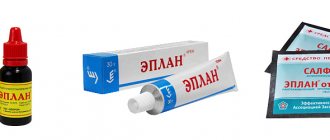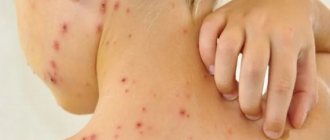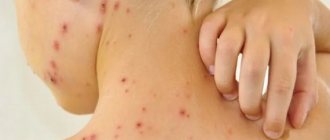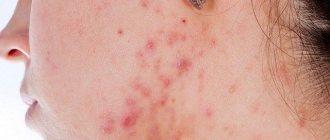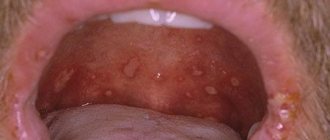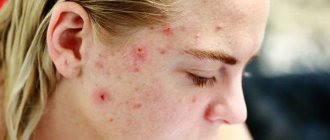More than 90% of people living with HIV suffer from skin rashes. An HIV rash takes the form of any skin disease and causes symptoms unusual for skin diseases. Skin irritation is the first sign of infection and appears in the first month after infection. Therapy for rashes is aimed at reducing the intensity and suppressing unpleasant sensations.
What does a rash look like in people with HIV?
The characteristics of the rash depend on the skin disease that caused it. The only thing that all types of rashes with HIV infection have in common is more pronounced redness and itching, difficulty in treatment, and frequent relapses. In the photo below you can see in more detail the nature of the rashes in various diseases.
Skin diseases in HIV-infected people are more severe than in uninfected people, and are accompanied by fever, enlarged lymph nodes, intestinal upset, body and throat pain, and sweating.
Seborrheic dermatitis
It is expressed in the appearance of red plaques, which become crusty over time. Inflammations appear first on the face, then spread to the scalp, the inside of the knees and elbows.
Plaques characteristic of seborrheic dermatitis form at an early stage of the disease in half of those infected.
Stomatitis
Bubbles, white plaque and ulcers of various sizes, also covered with white plaque, appear on the oral mucosa.
Stomatitis in an HIV-infected person, which occurs against the background of allergies, is accompanied by fever and sore throat. Rashes in the mouth are one of the first external signs of HIV infection.
Allergy
In patients with immunodeficiency, allergic urticaria is noted, which is accompanied by the appearance of red spots and a rash similar to an insect bite.
Kaposi's sarcoma
Characterized by skin spots and lumps in the form of burgundy colored bumps. The rashes are localized on the face, mouth (tongue), genitals, from where they spread to the torso, arms and legs. A year after HIV infection, the disease enters the final stage, in which many malignant neoplasms appear on the patient’s skin and mucous membranes.
Kaposi's sarcoma is more common in HIV-infected men.
Fungus
In case of fungal diseases, such as candidiasis, lichen, rubrophytia, foci of inflammation with pronounced peeling, redness, severe itching, and a white coating appear on the patient’s skin.
Irritation is first localized on the hands, feet and groin area, then quickly spreads throughout the body.
Exanthema
Rashes occur when the body becomes infected with an infection. Exanthema appears as a colorless or bright red papular rash. The location of the rash depends on the pathogen, but most often appears in the torso and groin area.
In HIV-infected people, exanthema is caused by herpes virus, cytomegalovirus, Coxsackie virus, enteroviruses, hepatitis C virus, molluscum contagiosum, and human papillomavirus.
Psoriasis
It appears as red plaques with clear boundaries, covered with gray scales.
The severity of skin lesions depends on the degree of impairment of the immune system.
Scabies
Scabies affects up to 30% of HIV-infected people. The disease is characterized by intense itching, worsening at night.
White or red S-shaped itch burrows appear on the hands, between the fingers, on the mammary glands, under the armpits, and in the groin.
Pyodermatitis
The rash occurs against the background of inflammation of the hair follicles and takes the form of burgundy pimples and pustules, reminiscent of a teenage rash.
Syphilis
With secondary syphilis, a pink or red maculopapular rash appears on the patient’s body, which spreads throughout the body.
Secondary syphilis occurs 3-4 months after infection with Treponema pallidum.
HIV infection - symptoms and treatment
HIV infection is a chronic infectious disease that is provoked by the human immunodeficiency virus, which infects cells of the immune system (CD4). If left untreated, it naturally leads to acquired immunodeficiency syndrome (AIDS).[6]
The human immunodeficiency virus belongs to the family of retroviruses (Retroviridae), genus Lentivirus. Information about the disease first appeared in 1970. The virus itself was isolated in 1983 simultaneously in France by virologist Françoise Barre-Sinoussi and in the USA by scientist Robert Galo, but it received a name approved by the World Health Organization only five years later - in 1987. At the same time, the first case of HIV infection was registered in the USSR.[1][2]
Currently, there are two types of virus - HIV-1 and HIV-2, which differ in their structural characteristics. In Russia, the USA, Europe and Central Africa, the first type of virus (HIV-1) is widespread; in India and West Africa, the second type of virus (HIV-2) is of epidemiological importance.
Under natural conditions, HIV remains active in a dried state for several hours, in biological fluids for several days, and in frozen blood serum for several years. When heated to 70-80°C, the virus dies in 10 minutes; when treated with a 70% ethyl alcohol solution, it is inactivated in one minute. Also sensitive to 0.5% sodium hypochlorite, 6% hydrogen peroxide, 5% Lysol, ether or acetone.[2]
The shape of the virus is round, in the center there is a core containing two strands of ribonucleic acid (RNA) and the enzymes necessary for reproduction - reverse transcriptase (revertase), integrase, protease, RNase. The core is surrounded by an inner protein and outer lipid shell. The inner envelope of HIV-1 consists of the proteins p17, p24 and p55. The outer shell is “pierced” by the glycoprotein gp160, which consists of fragments gp41 and gp120 (the so-called envelope proteins). Gp41 and gp120 on the surface of the virion form processes with which HIV attaches to the receptors of human target cells (cells of the body that have a receptor - the CD4 protein).[1][3]
How is HIV transmitted?
Ways of transmission of infection:
- Natural:
- sexual (hetero- and homosexual contacts);
- vertical (from an infected mother to a child during pregnancy, childbirth or breastfeeding).
- Artificial - parenteral (in the case of various effects associated with damage to the mucous membranes and skin, for example, the use of non-sterile instruments during the use of narcotic substances, medical and non-medical manipulations).
It is important to note that kissing, communicating, hugging, shaking hands, sharing utensils and other household items does not transmit HIV infection.
HIV in Russia
As of June 30, 2022, 1,528,356 people with a confirmed diagnosis of HIV infection have been identified in Russia, including: 1,122,879 patients living with HIV and 405,477 deaths.
HIV infection is actively spreading among the population. Thus, in the first half of 2022, 67.3% of people became infected through heterosexual contacts, 28.9% through drug use, and 2.9% through homosexual contacts.[7]
Chance of contracting HIV
Through unprotected vaginal intercourse, women become infected with HIV in approximately 8 cases out of 10,000, and men in 4 cases. During unprotected anal sex, the risk of contracting HIV is higher: the virus is transmitted to a passive partner in 138 cases out of 10,000, and to an active partner in 11 cases.[10]
HIV and pregnancy
Women who are prescribed antiretroviral therapy in a timely manner do not transmit the virus during pregnancy and childbirth. If the virus is suppressed, childbirth can be carried out naturally. However, breastfeeding, even while taking therapy, is contraindicated due to the high risk of infection of the child through breast milk.[3][4].
Diagnosis of rashes on the body
With HIV and AIDS, it is difficult to visually determine the type of rash - the nature of skin inflammation in infected people is different.
To determine the type of rash and its cause, the following diagnostic measures are carried out:
- Clinical analysis of blood and urine.
- Blood test for sexually transmitted viruses.
- Skin scraping. The method is used to detect intradermal mites and fungi that cause skin diseases.
- Blood tests for antibodies to allergens and allergy skin tests.
- Hormonal studies.
- Biopsy of skin lesions. They detect the presence of cancer cells, which is important for diagnosing Kaposi's sarcoma.
What is HIV?
HIV is a virus that damages the human immune system. It enters the body, attaches to the T-lymphocytes that help us fight infections, penetrates them, and injures or destroys them.
Without treatment, the disease affects more and more cells, gradually weakens the immune system over many years, and deprives us of natural defenses, after which the body simply cannot resist harmful microorganisms.
Today, HIV and its final stage, AIDS, are still incurable. Vaccinations or means that would allow one to forget about it once and for all still do not exist, but there are medications that provide a person with this diagnosis with a normal life expectancy, almost the same as that of his healthy peers.
Yes, you will have to go to doctors, get the necessary medications and remember to drink them, as do, for example, those with rheumatoid arthritis, whose joints are gradually destroyed, or asthma, but life does not end there, and for many, no matter how strange these no matter how it sounds, it’s just beginning.
Consequences of infection with the human immunodeficiency virus
Once the diagnosis is confirmed, antiretroviral therapy is selected. It includes constant use of drugs (usually Nevirapine, Didanosine, Zidovudine are prescribed). These drugs prevent the virus from entering cells, keeping the immune system from being destroyed. You will have to take pills for the rest of your life.
If sick people do not take medications, the destruction of the immune system continues.
Gradually, HIV turns into AIDS - acquired immunodeficiency syndrome. At this stage, the body is unable to resist any disease, and even a mild cold can kill. The patient has several months left to live; drug therapy does not work.
Which doctor should I contact?
Due to the fact that in the early stages, signs of HIV infection resemble a common cold, patients usually seek a first consultation with a general practitioner.
If an immunodeficiency virus is suspected, a referral is issued to an infectious disease specialist, who prescribes the necessary diagnostic measures and, if the diagnosis is confirmed, selects treatment.
Bacterial infections
Ulcerative-necrotizing gingivitis develops in HIV-infected individuals both during various periods of clinical manifestations of AIDS, and without them in the presence of antibodies against the virus. Patients complain of pain and bleeding gums while brushing their teeth and eating; bad breath. Upon examination, a gray-yellow plaque (necrotic film) is found covering the gingival margin and interdental papillae. The mucous membrane in the gum area is hyperemic, swollen, and tense.
After treatment, the symptoms disappear, but there is a tendency to relapse. A prolonged course can lead to deep ulcers with damage to bone structures and necrotization of the interdental septum (Fig. 4).
Rice. 4. Herpes simplex on the lip.
The consequence of gingivitis is periodontitis (periodontitis) with irregular generalized destruction of bone tissue and the supporting-retaining apparatus of the tooth. Treatment of patients does not provide lasting results.
Fungal infections
Candidal stomatitis is diagnosed in the vast majority of AIDS patients (up to 75%) and manifests itself in several clinical forms.
Pseudomembranous candidiasis often begins as acute, but with AIDS it can continue or recur, and therefore is considered as a chronic process. Fungal infection is characterized by the presence of a yellowish coating on the oral mucosa, which may be hyperemic or unchanged in color. Plaque is tightly held on the surface of the epithelium and is difficult to remove. This exposes bleeding areas of the mucosa. The favorite localization of plaque is the cheeks, lips, tongue, hard and soft palate (Fig. 1).
Rice. 1. Pseudomembranous candidiasis. Raid in the sky.
Erythematous, or atrophic, candidiasis develops in the form of bright red spots or diffuse hyperemia, and in AIDS it has a chronic course. The palate is most often affected and acquires an uneven bright red color. The epithelium becomes thinner and erosions may appear. Localization of lesions on the dorsum of the tongue leads to atrophy of the filiform papillae along the midline (in contrast to this picture, age-related changes in the tongue are characterized by diffuse atrophy; in syphilis, atrophy of the filiform papilla takes the form of foci of a mowed meadow) (Fig. 2).
Rice. 2. Erymatous candidal glossitis.
Chronic hyperplastic candidiasis is characterized by the symmetrical arrangement of elements on the mucous membrane of the cheeks in the form of polygonal elevated foci of hyperplasia, covered with a yellow-white, cream, yellowish-brown coating. The hyperplastic form of candidiasis is much less common. Researchers attribute this manifestation to exposure to nicotine from smoking (Fig. 3).
Fig.3. Hyperplastic candidiasis.
Fungal infections of the oral mucosa can be combined with candidiasis of the corners of the mouth - angular cheilitis, which is a sign of generalization of the process.
The diagnosis, which is made on the basis of clinical manifestations, must be confirmed by laboratory tests. Active growth of a large number of colonies (hundreds) on a nutrient medium, detection of mycelium during microscopy of samples indicate the pathogenicity of the Candida fungus. In some cases, a biopsy is necessary.
Treatment of candidiasis can be systemic or local, depending on the extent of the process. Etiotropic effects are mandatory, symptomatic effects depend on clinical manifestations.
HIV tests, prices, when to get tested
According to testing standards, blood for HIV is donated three times after the threat of infection - 3, 6 and 12 months from the moment of suspected infection. It is not at all necessary to do this at home using pharmacy tests or in private clinics. The best decision would be to contact the AIDS CENTER, which is in every city, and describe the situation to the doctor. The doctor will decide whether emergency prevention of HIV infection is needed (antiviral drugs are prescribed) or whether there is no threat to health. Examination and treatment when visiting such a center are free of charge.
Victoria Druzhikina
Neurologist, Therapist
You can donate blood yourself in a private clinic; the average cost of the test is 400 rubles.
Life expectancy with timely detection of the virus and early initiation of therapy does not differ from the life expectancy of a person without HIV infection. Without treatment, the condition enters the AIDS phase, which is approximately 5-10 years before death.
This article has been verified by a current qualified physician, Victoria Druzhikina, and can be considered a reliable source of information for site users.
Bibliography
1.https://aidsvolgograd.ru/wp-content/uploads/2017/08/Clinical-protocols-HIV-2017.pdf 2.https://www.rcrz.kz/docs/clinic_protocol/2015/Therapy/Infectious %20diseases/3%20HIV%20y%20adults.pdf
Rate how helpful this article was
4.3 12 people voted, average rating 4.3
Did you like the article? Save it to your wall so you don’t lose it!
